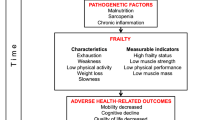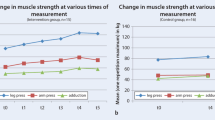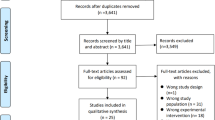Abstract
Background and aims: There are few studies published that combine the interventions of physical training and nutrition. The aim of the present study was to describe the impact of a physical and nutritional intervention program for frail community-dwelling elderly people over the age of 75. Methods: Ninety-six community-dwelling elderly people (58 women) were randomized to four different groups: i) a physical training program (aerobic, muscle strength, balance), ii) a nutritional intervention program (individually targeted advice and group sessions), iii) a combination of these interventions, and iv) a control group. At baseline subjects were screened for physical performance such as muscle strength, balance, mobility and activities of daily living, as well as nutritional aspects such as energy intake, body weight and fat-free mass. These measurements were repeated immediately after the intervention, which lasted for 12 weeks, and after another 6 months. Results: The intention-to-treat analysis indicated significant improvements in lower-extremity muscle strength in both training groups compared with the nutrition group at 1st follow-up. There were small significant changes for some of the balance measurements in the training group without nutrition treatment. The nutrition intervention did not show any significant results. Conclusions: This study shows the positive effect on lower-extremity muscle strength directly after the intervention. Balance training most probably needs to be more individualized in order to be effective for frail elderly people. Further studies are needed, with larger sample sizes, to investigate the effects of these types of interventions before any further conclusions can be drawn.
Similar content being viewed by others
References
Fried LP, Tangen CM, Walston J, et al. Frailty in older adults: evidence for a phenotype. J Gerontol A Biol Sci Med Sci 2001; 56: M146–56.
Chin A Paw MJ, Dekker JM, Feskens EJ, Schouten EG, Kromhout D. How to select a frail elderly population? A comparison of three working definitions. J Clin Epidemiol 1999; 52: 1015–21.
Studenski S, Hayes RP, Leibowitz RO, et al. Clinical global impression of change in physical frailty: development of a measure based on clinical judgment. J Am Geriatr Soc 2004; 52: 1560–6.
Fiatarone MA, O’Neill EF, Ryan ND, et al. Exercise training and nutritional supplementation for physical frailty in very elderly people. N Engl J Med 1994; 330: 1769–75.
Bonnefoy M, Cornu C, Normand S, et al. The effects of exercise and protein-energy supplements on body composition and muscle function in frail elderly individuals: a long-term controlled randomized study. Br J Nutr 2003; 89: 731–9.
de Jong N, Chin A Paw MJM, de Groot LC, Hiddink GJ, van Staveren WA. Dietary supplements and physical exercise affecting bone and body composition in frail elderly persons. Am J Public Health 2000; 90: 947–54.
Chin A Paw MJM, de Jong N, Schouten EG, Hiddink GJ, Kok FJ. Physical exercise and/or enriched foods for functional improvement in frail, independently living elderly: a randomized controlled trial. Arch Phys Med Rehabil 2001; 82: 811–7.
Shumaker SA, Dugan E, Bowen DJ. Enhancing adherence in randomized controlled clinical trials. Control Clin Trials 2000; 21 (Suppl. 5): 226S–32.
McAuley E, Jerome GJ, Elavsky S, Marquez DX, Ramsey SN. Predicting long-term maintenance of physical activity in older adults. Prev Med 2003; 37: 110–8.
Schutzer KA, Graves BS. Barriers and motivations to exercise in older adults. Prev Med 2004; 39: 1056–61.
Taylor SE. Health Psychology. 4th ed. Singapore: McGraw-Hill Book Co, 1999.
Mattiasson-Nilo I, Sonn K, Johannesson K, Gosman-Hedström G, Person GB, Grimby G. Domestic activities and walking in elderly: evaluation from a 30-hour heart rate recording. Aging Clin Exp Res 1990; 2: 191–8.
Frändin K, Grimby G. Assessment of physical activity, fitness and performance in 76-year-olds. Scand J Med Sci Sports 1994; 4: 41–6.
Callahan CM, Unverzagt FW, Hui SL, Perkins AJ, Hendrie HC. Six-item screener to identify cognitive impairment among potential subjects for clinical research. Med Care 2002; 40: 771–81.
Phillips WT, Batterham AM, Julie E, Valenzuela JE, Burkett LN. Reliability of maximal strength testing in older adults. Arch Phys Med Rehabil 2004; 85: 329–34.
Rydwik E, Karlsson C, Frändin K, Akner G. Muscle strength testing with one repetition maximum in the arm/shoulder for people aged 75+ — test-retest reliability. Clin Rehabil 2007; 21: 258–65.
American College of Sports Medicine (ACSM). ACSM’s guidelines for exercise testing and prescription. Baltimore: Williams & Wilkins 1993.
Jones CJ, Rikli RE, Beam WC. A 30-s chair-stand test as a measure of lower body strength in community-residing older adults. Res Quar Exerc Sport 1999; 70: 113–9.
Franchignoni F, Tesio L, Martino MT, Ricupero C. Reliability of four simple, quantitative tests of balance and mobility in healthy elderly females. Aging Clin Exp Res 1998; 10: 26–31.
Lin M-R, Hwang H-F, Hu M-H, Wu H-DI, Wang Y-W, Huang F-C. Psychometric comparisons of the Timed Up and Go, One-leg stand, Functional reach, and Tinetti balance measures in community-dwelling older people. J Am Geriatr Soc 2004; 52: 1343–8.
Jarnlo G-B, Nordell E. Reliability of the modified figure of eight — a balance performance test for elderly women. Phys Ther Pract 2003; 19: 35–43.
Frändin K, Sonn U, Svantesson U, Grimby G. Functional balance tests in 76-year-olds in relation to performance, activities of daily living and platform tests. Scand J Rehabil Med 1995; 27: 231–41.
Sherrington C, Lord SR. Reliability of simple portable tests of physical performance in older people after hip fracture. Clin Rehabil 2005; 19: 496–504.
Podsiadlo D, Richardson S. The Timed Up and Go: a test of basic functional mobility for frail elderly persons. J Am Geriatr Soc 1991; 39: 142–8.
Lundin-Olsson L, Nyberg L, Gustafsson Y. Attention, frailty and falls: The effect of a manual task on basic mobility. J Am Geriatr Soc 1998; 46: 758–61.
Steffen TM, Hacker TA, Mollinger L. Age-and-gender related test performance in community-dwelling elderly people: six-minute walk test, Berg’s Balance scale, Timed Up and Go, and Gait speeds. Phys Ther 2002; 82: 128–37.
Kidd D, Stewart G, Baldry J, et al. The Functional Independence Measure: a comparative validity and reliability study. Disabil Rehabil 1995; 1: 10–14.
Daving Y, Andrén E, Nordholm L, Grimby G. Reliability of an interview approach to the Functional Independence Measure. Clin Rehabil 2001; 15: 301–10.
Grimby G, Andrén E, Daving Y, Wright B. Dependence and perceived difficulty in daily activities in community-living stroke survivors 2 years after stroke. Stroke 1998; 29: 1843–9.
Daving Y, Andrén E, Grimby G. Inter-rater agreement using the Instrumental Activity Measure. Scand J Occup Ther 2000; 7: 33–8.
Edwards DA, Hammond WH, Healy MJ, et al. Design and accuracy of callipers for measuring subcutaneous tissue thickness. Br J Nutr 1955; 9: 133–43.
Siri W. Techniques for measuring body composition. In Edition Washington D.C.: National Academy of Sciences, National Research Council, 1961.
Durnin JV, Womersley J. Body fat assessed from total body density and its estimation from skinfold thickness: measurements on 481 men and women aged from 16 to 72 years. Br J Nutr 1974; 32: 77–97.
Borg GA. Psychophysical bases of perceived exertion. Med Sci Sports Exerc 1982; 14: 77–81.
Ferrucci L, Guralnik JM, Studenski S, Fried LP, Cutler GB, Walston JD. Designing randomized, controlled trials aimed at preventing or delaying functional decline and disability in frail older persons: a consensus report. J Am Geriatr Soc 2004; 52: 625–34.
Chin A Paw MJM, van Poppel MNM, Twisk JWR, van Mechelen W. Once a week not enough, twice a week not feasible? A randomised controlled exercise trial in long-term care facilities. Patient Educ Couns 2006; 63: 205–14.
Rydwik E, Frändin K, Akner G. Effects of physical training on physical performance in institutionalised elderly patients (70+) with multiple diagnoses. Age Ageing 2004; 33: 13–23.
Wolf S, Barnhardt HX, Kutner NG, Mc Neely E, Coogler C, Xu T. Reducing frailty and falls in older persons: an investigation of Tai Chi and computerized balance training. Atlanta FICSIT Group. J Am Geriatr Soc 1996; 44: 489–97.
Wolfson L, Whipple R, Derby C, et al. Balance and strength training in older adults: intervention gains and Tai Chi maintenance. J Am Geriatr Soc 1996; 44: 498–506.
Dewalt DA, Pignone MP. The role of literacy in health and health care. Am J Pub Med 2005; 72: 387–8.
Stratton RJ, Green CJ, Elia M. Disease-related malnutrition: an evidence based approach to treatment. CAB International, Wallingford, UK, 2003: 12–14.
Nordhamn K, Södergren E, Olsson E, Karlström B, Vessby B, Berglund L. Reliability of anthropometric measurements in overweight and lean subjects: consequences for correlations between anthropometric and other variables. Int J Obes 2000; 24: 652–7.
Author information
Authors and Affiliations
Corresponding author
Rights and permissions
About this article
Cite this article
Rydwik, E., Lammes, E., Frändin, K. et al. Effects of a physical and nutritional intervention program for frail elderly people over age 75. A randomized controlled pilot treatment trial. Aging Clin Exp Res 20, 159–170 (2008). https://doi.org/10.1007/BF03324763
Received:
Accepted:
Published:
Issue Date:
DOI: https://doi.org/10.1007/BF03324763




